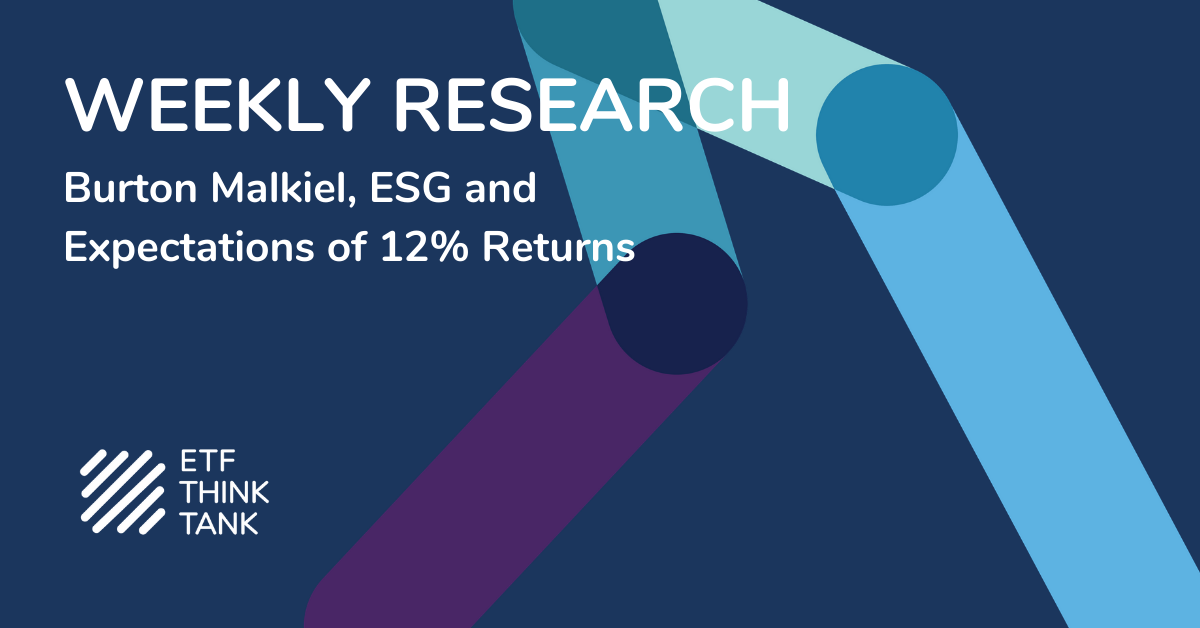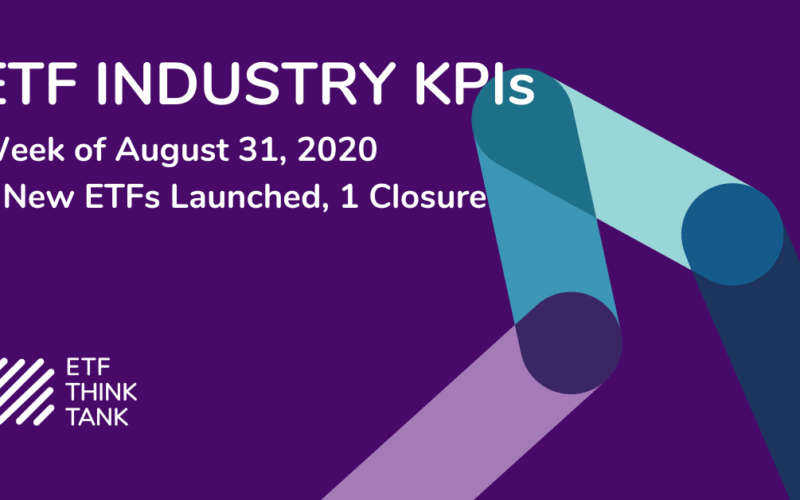God bless America, the US Dollar, and the optimism of the millennial investors who see the opportunity to create change through ESG investing and optimizing returns! According to CNBC, a survey by Schroders suggests that the global millennial investor looking for a 12% compound return may be inspiring optimism in this market that arguably could be intoxicating. The actual survey can be found here; optimism is highest in the Americas, at 13.2%. [1]

Surveys and rhetoric may capture attention in the short term, but wisdom is best shared by those with experience. In a July interview with Andrea Riquier, Burton Malkiel spoke about markets serving the urge to gamble. This week, during our Thursday Get Think Tanked Happy Hour, we have the opportunity to further expand on his views and the potential outcomes from excess expectation and optimism. Burton Malkiel wrote a book, A Random Walk Down Wall Street, that answered questions like this back in 1973. Today, he is a professor emeritus at Princeton University, CIO at Wealth Front and Advisor to Rebalance and EMQQ (Wikipedia). Investors may credit John Bogle for launching Vanguard in 1975, but Burton Malkeil’s book, and participation as a director at Vanguard until 2005, helped shape its success. If that’s not enough – ETF Nerds can also be impressed that he holds both a bachelor’s degree and an MBA from Harvard University, as well as a Ph.D. in economics from Princeton University.
A Few Questions for this Week’s Happy Hour
During the Happy Hour this week, we plan to address many questions, including these:
- Investor optimism, according to the Schroder poll, indicates American investors’ return expectations are the highest globally. Clearly this is evidence that home bias exists in America. Is this becoming self-fulfilling with so much wealth tied to a few stocks and a small group of people? Should investors be rebalancing away from the home bias now that performance is concentrated among a few key companies and one sector – technology?
- Is there room in investors’ portfolios for a targeted approach to sector allocation, or should every sector be considered for broad allocation for purposes of diversification and/or a more targeted approach?
- There is over $11.2 Trillion of investor money that is bench marketed to the S&P 500, which includes about $4.6 Trillion in index money. Bigger has become better with investing, and especially embraced by momentum investors. Sure, Apple blew away expectations during its last earnings report, but at what point will there be diminishing returns, law of large numbers or a problem where expectations are too high and failure becomes inevitable? Either market breadth spreads out or Apple, at $2 Trillion, needs a major increase in flows towards its stock. Earnings will be released October 30th. The 5-year average PE for Apple is 15.4, and similar multiples to EBITDA, EBIT and Revenues are all about 2x historical average. Similar multiple exists with Microsoft (MSFT), Amazon (AMZN), Facebook (FB) and Alphabet (GOOG). Yardeni Research makes the point clear in a number of charts relating to why technology is working for the S&P 500. Our favorite from September 2nd is figure 6, because it highlights how extremes can go and how market cycles across sectors, using forward earnings and revenues, can change.
A Few Questions for this Week’s Happy Hour
During the Happy Hour this week, we plan to address many questions, including these:
- Investor optimism, according to the Schroder poll, indicates American investors’ return expectations are the highest globally. Clearly this is evidence that home bias exists in America. Is this becoming self-fulfilling with so much wealth tied to a few stocks and a small group of people? Should investors be rebalancing away from the home bias now that performance is concentrated among a few key companies and one sector – technology?
- Is there room in investors’ portfolios for a targeted approach to sector allocation, or should every sector be considered for broad allocation for purposes of diversification and/or a more targeted approach?
- There is over $11.2 Trillion of investor money that is bench marketed to the S&P 500, which includes about $4.6 Trillion in index money. Bigger has become better with investing, and especially embraced by momentum investors. Sure, Apple blew away expectations during its last earnings report, but at what point will there be diminishing returns, law of large numbers or a problem where expectations are too high and failure becomes inevitable? Either market breadth spreads out or Apple, at $2 Trillion, needs a major increase in flows towards its stock. Earnings will be released October 30th. The 5-year average PE for Apple is 15.4, and similar multiples to EBITDA, EBIT and Revenues are all about 2x historical average. Similar multiple exists with Microsoft (MSFT), Amazon (AMZN), Facebook (FB) and Alphabet (GOOG). Yardeni Research makes the point clear in a number of charts relating to why technology is working for the S&P 500. Our favorite from September 2nd is figure 6, because it highlights how extremes can go and how market cycles across sectors, using forward earnings and revenues, can change.


- The ETF Think Tank is about sharing insights, due diligence and security selection. For portfolio construction purposes, this begs the question: how much exposure should a portfolio have to trillion-dollar companies, given the high expectations? Clearly, margin expansion and disruption can come through targeted approaches to investing, and active share can add value and diversification. Large companies, like aircraft carriers, will always be hard to maneuver, and issues with the dollar could surprise some investors and lead to a re-allocation to cycles. Call it reversion to the mean? Should we question the optimism of American investors who may be complacent with the success felt at home, while other foreign governments maneuver to make better lives for their own constituencies. To put it differently, the expansion of China, in the long term, is inevitable. However, one has to ask how much debt is prudent for China to hold in US dollars – especially as it shows a decline in value, due in part to so much stimulus. This question was highlighted on Friday by Tyler Durden at ZeroHedge: China To “Gradually” sell 20% Of Its US Treasury Holdings, may Dump It All In Case of Military Conflicts: State Media. As a debtor nation, one trillion dollars of borrowings is meaningful no matter how you cut it.
- All this brings us back to ESG investing which, as we spoke about a couple of weeks ago, is heavily skewed towards large cap technology. To that end, rather than sharing our personal views on ESG through part 2, we should ask our esteemed guest whether the power of money can be used to affect both change and optimized returns. Telegraphing a couple of key questions:
-
- Is ESG a reflection of an investor base who has stayed too long at the casino table and thinks they can outsmart the house?
- What would have happened if ESG had taken off in the 1970s?
- Can ESG be indexed, or is it about social disruption and needs to be active?
The ETF Think Tank is about shared insights, and we are very proud to share this opportunity as an open forum. We will cover a great deal on Thursday at 5pm (sign up here). We expect a lot of questions for Dr. Malkiel. Feel free to share questions in advance, but as is always the case, the chat will be open.
[1] https://www.schroders.com/en/sysglobalassets/_global-shared-blocks/gis-2020/theme-1/schrodersgis2020_full-report_eng.pdf
Disclosure
The information provided here is for financial professionals only and should not be considered an individualized recommendation or personalized investment advice. The investment strategies mentioned here may not be suitable for everyone. Each investor needs to review an investment strategy for his or her own particular situation before making any investment decision.
All expressions of opinion are subject to change without notice in reaction to shifting market conditions. Data contained herein from third party providers is obtained from what are considered reliable sources. However, its accuracy, completeness or reliability cannot be guaranteed.
Examples provided are for illustrative purposes only and not intended to be reflective of results you can expect to achieve.
All investments involve risk, including possible loss of principal.
The value of investments and the income from them can go down as well as up and investors may not get back the amounts originally invested, and can be affected by changes in interest rates, in exchange rates, general market conditions, political, social and economic developments and other variable factors. Investment involves risks including but not limited to, possible delays in payments and loss of income or capital. Neither Toroso nor any of its affiliates guarantees any rate of return or the return of capital invested. This commentary material is available for informational purposes only and nothing herein constitutes an offer to sell or a solicitation of an offer to buy any security and nothing herein should be construed as such. All investment strategies and investments involve risk of loss, including the possible loss of all amounts invested, and nothing herein should be construed as a guarantee of any specific outcome or profit. While we have gathered the information presented herein from sources that we believe to be reliable, we cannot guarantee the accuracy or completeness of the information presented and the information presented should not be relied upon as such. Any opinions expressed herein are our opinions and are current only as of the date of distribution, and are subject to change without notice. We disclaim any obligation to provide revised opinions in the event of changed circumstances.
The information in this material is confidential and proprietary and may not be used other than by the intended user. Neither Toroso or its affiliates or any of their officers or employees of Toroso accepts any liability whatsoever for any loss arising from any use of this material or its contents. This material may not be reproduced, distributed or published without prior written permission from Toroso. Distribution of this material may be restricted in certain jurisdictions. Any persons coming into possession of this material should seek advice for details of and observe such restrictions (if any).
Topics: Weekly Research











